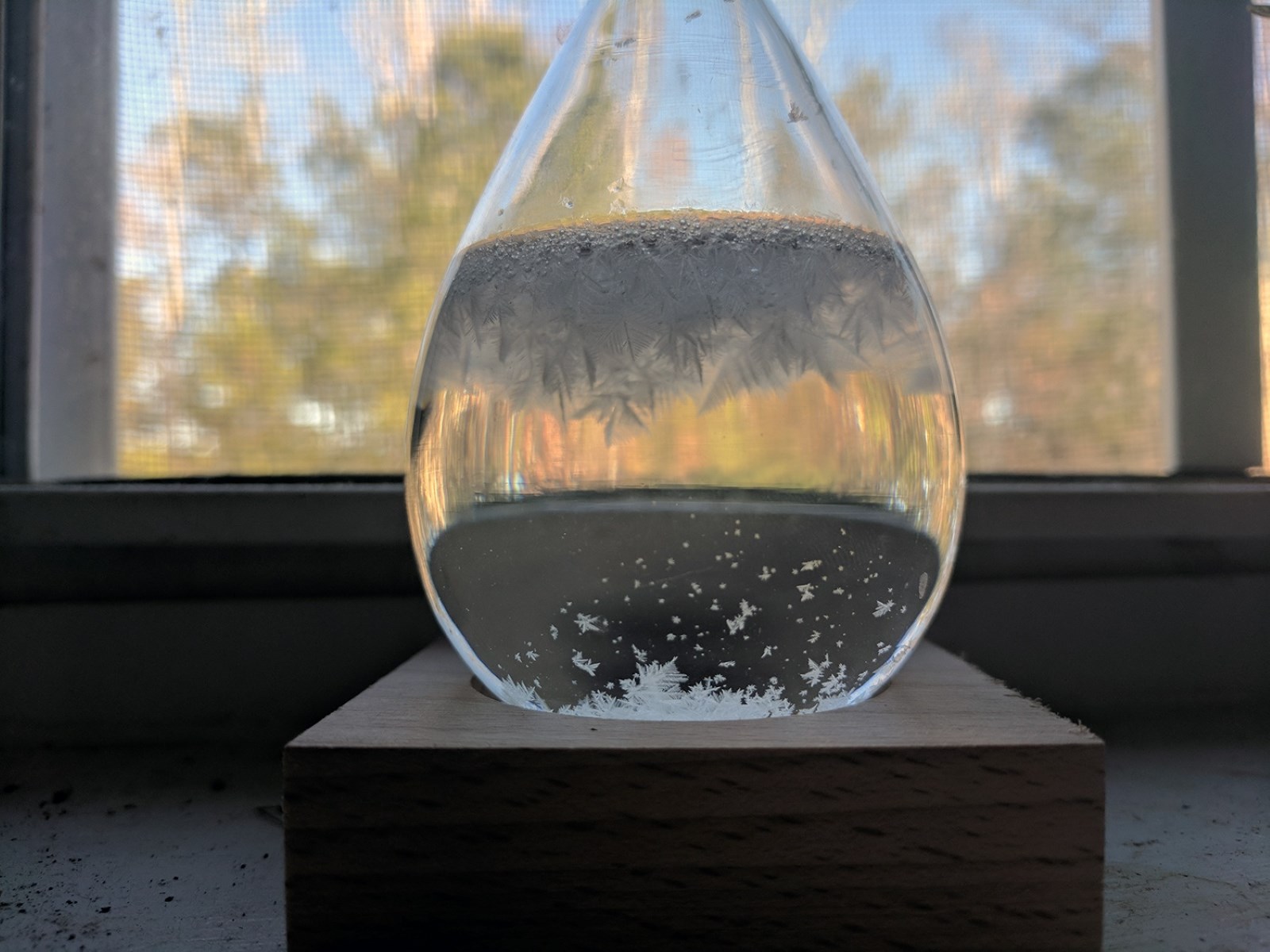Home>Furniture & Design>Interior Design Trends>How To Read A Storm Glass


Interior Design Trends
How To Read A Storm Glass
Modified: August 17, 2024
Discover the latest interior design trends with our guide on how to read a storm glass. Stay ahead of the curve with this unique and stylish decor piece.
(Many of the links in this article redirect to a specific reviewed product. Your purchase of these products through affiliate links helps to generate commission for Storables.com, at no extra cost. Learn more)
Introduction
The storm glass, an intriguing and enigmatic device, has captivated the curiosity of many individuals throughout history. Its mesmerizing crystal formations seem to hold the secrets of the weather, offering a glimpse into the atmospheric changes that lie ahead. This ancient weather forecasting instrument, with its origins dating back to the 18th century, continues to pique the interest of modern enthusiasts and weather aficionados.
The allure of the storm glass lies in its ability to seemingly predict weather patterns through the delicate dance of its crystals. As the atmospheric pressure and temperature fluctuate, the liquid within the glass container responds by forming unique crystalline structures. These formations, often resembling delicate fern-like patterns or intricate starbursts, serve as visual indicators of the atmospheric conditions.
While the storm glass's accuracy in weather prediction has been a subject of debate, its mystique and charm remain undeniable. Whether displayed as an ornamental piece or used as a conversation starter, the storm glass holds a timeless appeal that transcends its practical function. Its presence in homes, offices, and even maritime settings adds an air of intrigue and elegance, inviting individuals to ponder the mysteries of weather forecasting and the forces of nature.
In the following sections, we will delve deeper into the workings of the storm glass, exploring the factors that influence its crystal formations and offering insights into interpreting its enigmatic displays. By gaining a better understanding of this captivating instrument, you will be equipped to appreciate its beauty and potentially unravel the atmospheric clues it presents. Let's embark on a journey to unravel the secrets of the storm glass and unlock the captivating world of weather prediction.
Key Takeaways:
- The storm glass, with its mesmerizing crystal formations, offers a captivating glimpse into potential weather changes based on the shapes of its crystals, such as feathery patterns for fair weather and star-like structures for colder temperatures.
- By observing and understanding the storm glass’s crystal formations, individuals can gain valuable insights into potential weather patterns, enhancing their appreciation for the delicate interplay between nature’s forces and human curiosity.
Read more: How To Read A Glass Barometer
Understanding the Storm Glass
The storm glass, also known as a weather glass or camphor glass, is a fascinating instrument that has intrigued scientists, sailors, and weather enthusiasts for centuries. This unique device consists of a sealed glass container filled with a mixture of distilled water, ethanol, potassium nitrate, ammonium chloride, and camphor. The precise composition of the liquid within the storm glass is a closely guarded secret, adding an air of mystery to its inner workings.
The key to the storm glass's allure lies in its ability to respond to changes in atmospheric conditions, particularly variations in temperature and pressure. When exposed to fluctuations in these environmental factors, the liquid within the glass container undergoes subtle transformations, leading to the formation of distinct crystal patterns. These formations, which range from delicate feathery structures to intricate star-like shapes, serve as visual indicators of the prevailing weather conditions.
The exact mechanism behind the storm glass's responsiveness to atmospheric changes remains a subject of fascination and speculation. While some attribute its behavior to the influence of temperature and pressure on the solubility of the chemical compounds within the liquid, others point to the role of electromagnetic fields and ionization processes. Regardless of the underlying scientific principles at play, the storm glass continues to captivate individuals with its mesmerizing displays and enigmatic predictions.
In addition to its aesthetic appeal, the storm glass holds historical significance, having been utilized as a rudimentary weather forecasting tool aboard ships during the 18th and 19th centuries. Sailors and navigators would observe the crystal formations within the storm glass to gain insights into impending weather changes, allowing them to make informed decisions while at sea. This practical application underscores the enduring relevance of the storm glass as a symbol of humanity's enduring quest to understand and predict the forces of nature.
As we unravel the mysteries of the storm glass, we gain a deeper appreciation for its role in historical weather prediction and its continued allure as a decorative and thought-provoking instrument. By comprehending the fundamental principles that govern its behavior, we can embark on a journey to interpret its crystal formations and unlock the atmospheric secrets it holds. The storm glass stands as a testament to the timeless fascination with weather forecasting and the enduring appeal of instruments that bridge the realms of science and art.
Interpreting the Crystal Formations
The mesmerizing crystal formations within the storm glass serve as captivating visual indicators of the prevailing atmospheric conditions. As the ambient temperature and pressure fluctuate, the liquid within the glass container undergoes subtle transformations, leading to the emergence of distinct and intricate crystal patterns. Interpreting these formations requires a keen eye and an understanding of the potential weather implications they convey.
-
Feathery Crystals: When delicate, fern-like crystals begin to form within the storm glass, it often indicates the likelihood of fair weather or clear skies. These elegant formations, resembling frost patterns on a windowpane, suggest stable atmospheric conditions with minimal turbulence. Observing feathery crystals within the storm glass may serve as a reassuring sign of tranquil weather ahead.
-
Star-Like Structures: The appearance of intricate starburst or dendritic crystal formations within the storm glass hints at the possibility of colder temperatures on the horizon. These striking patterns, reminiscent of frost crystals on a cold winter morning, often coincide with a drop in ambient temperature. The emergence of star-like structures within the storm glass prompts vigilance for potential chilly weather or a shift towards cooler atmospheric conditions.
-
Cloudy or Murky Appearance: In contrast to the defined crystal formations, a cloudy or murky appearance within the storm glass suggests unsettled weather patterns. The lack of distinct crystal structures may indicate atmospheric instability, potentially heralding the onset of precipitation or turbulent weather. Observing a cloudy or opaque appearance within the storm glass serves as a cautionary signal to remain attentive to changing weather dynamics.
-
Clear Liquid: When the liquid within the storm glass appears clear and devoid of any discernible crystal formations, it may signify a period of stable and consistent weather. This absence of crystalline structures suggests a relative equilibrium in atmospheric conditions, offering a respite from significant weather fluctuations. A clear liquid within the storm glass hints at a period of atmospheric calm and predictability.
By closely observing the crystal formations within the storm glass and discerning their potential implications, individuals can gain valuable insights into the prevailing weather patterns. While the storm glass's predictive accuracy may be subject to interpretation, its ability to evoke wonder and contemplation remains undiminished. The enigmatic dance of crystals within the storm glass invites us to embrace the art of weather interpretation and appreciate the delicate interplay between nature's forces and human curiosity.
When reading a storm glass, pay attention to the crystal formations. If the crystals are at the top, it indicates fair weather, while crystals at the bottom suggest stormy weather.
Factors Affecting the Storm Glass
The behavior of the storm glass, characterized by the formation of intricate crystal patterns in response to atmospheric changes, is influenced by a myriad of factors. Understanding these influential elements sheds light on the enigmatic workings of this captivating instrument and enhances our ability to interpret its predictions.
-
Temperature Fluctuations: One of the primary factors affecting the storm glass is temperature variation. As ambient temperatures rise or fall, the density and solubility of the liquid within the glass container undergo subtle shifts, leading to the formation of distinct crystal patterns. Higher temperatures may result in the dissolution of crystals, while cooler temperatures encourage crystallization, thereby influencing the visual display within the storm glass.
-
Atmospheric Pressure: Changes in atmospheric pressure exert a significant impact on the behavior of the storm glass. Fluctuations in barometric pressure, often associated with impending weather changes, influence the equilibrium of the liquid and its propensity to form crystalline structures. Low pressure may prompt the appearance of specific crystal formations, while high pressure conditions could yield contrasting patterns within the storm glass.
-
Light Exposure: The storm glass's sensitivity to light exposure also plays a role in its responsiveness to environmental stimuli. Direct sunlight or prolonged exposure to artificial light sources may affect the temperature of the glass container, potentially influencing the crystal formations. Shielding the storm glass from excessive light exposure helps maintain the integrity of its predictions and minimizes external variables that could impact its performance.
-
Location and Placement: The positioning of the storm glass within its environment can impact its responsiveness to atmospheric changes. Placing the instrument near sources of heat or cold drafts may introduce localized temperature variations, affecting the equilibrium of the liquid and altering the crystal formations. Strategic placement in a stable environment ensures more consistent and reliable predictions from the storm glass.
-
Liquid Composition: The precise composition of the liquid mixture within the storm glass, comprising distilled water, ethanol, potassium nitrate, ammonium chloride, and camphor, contributes to its unique reactivity to environmental stimuli. The intricate interplay of these chemical components, carefully balanced to facilitate the formation of crystal patterns, underscores the complexity of the storm glass's inner workings and its sensitivity to external influences.
By recognizing the multifaceted factors that influence the behavior of the storm glass, we gain a deeper appreciation for its intricacies and the art of weather interpretation. The interplay of temperature, pressure, light exposure, placement, and liquid composition collectively shapes the mesmerizing crystal formations within the storm glass, inviting us to contemplate the delicate dance between nature's forces and the human quest for atmospheric insight.
Tips for Reading the Storm Glass
Understanding the nuances of reading a storm glass enhances the ability to interpret its enigmatic predictions. Here are valuable tips for effectively observing and deciphering the mesmerizing crystal formations within the storm glass:
-
Consistent Observation: Regularly observing the storm glass allows for the identification of recurring patterns and correlations between crystal formations and subsequent weather changes. Consistent monitoring provides valuable insights into the instrument's predictive tendencies.
-
Record Keeping: Maintaining a log of observed crystal formations alongside corresponding weather conditions enables the establishment of patterns and associations. This practice facilitates the development of a personalized reference guide for interpreting the storm glass's predictions.
-
Environmental Awareness: Being mindful of the immediate environmental conditions, such as ambient temperature and barometric pressure, enhances the contextual understanding of the storm glass's crystal formations. Awareness of local weather forecasts and atmospheric dynamics further enriches the interpretation process.
-
Patience and Observation: The formation of crystal patterns within the storm glass may not always align with immediate weather changes. Patient observation over extended periods allows for a comprehensive understanding of the instrument's predictive behavior and its relevance to impending weather shifts.
-
Avoiding Interference: Minimizing external influences, such as direct sunlight, drafts, or abrupt temperature fluctuations, preserves the integrity of the storm glass's predictions. Shielding the instrument from extraneous variables ensures more accurate and reliable readings.
-
Collaborative Observations: Engaging in discussions and knowledge-sharing with fellow enthusiasts or meteorology experts fosters a collaborative approach to interpreting the storm glass's predictions. Sharing observations and insights contributes to a collective understanding of its predictive capabilities.
-
Appreciation of Variability: Acknowledging the inherent variability in weather patterns and the storm glass's predictions cultivates a nuanced perspective. Embracing the instrument's capacity for subtle and nuanced indications fosters a deeper appreciation for its enigmatic nature.
By incorporating these tips into the practice of reading the storm glass, individuals can elevate their ability to interpret its predictions and appreciate the captivating interplay between atmospheric dynamics and the instrument's mesmerizing crystal formations.
Read more: How To Read A Glass Thermometer
Conclusion
In conclusion, the storm glass stands as a timeless symbol of humanity's enduring fascination with weather prediction and the enigmatic forces of nature. Its mesmerizing crystal formations, influenced by temperature, pressure, light exposure, and liquid composition, invite individuals to embark on a journey of interpretation and contemplation. While the storm glass's predictive accuracy may be subject to interpretation and debate, its allure as a decorative and thought-provoking instrument remains undiminished.
By unraveling the mysteries of the storm glass and gaining insights into its inner workings, enthusiasts and weather aficionados can cultivate a deeper appreciation for its historical significance and enduring relevance. The delicate dance of crystals within the storm glass serves as a reminder of the intricate interplay between environmental stimuli and the instrument's responsiveness, offering a captivating fusion of science and art.
As we navigate the art of reading the storm glass, consistent observation, record-keeping, environmental awareness, and collaborative discussions enrich the interpretation process, fostering a deeper understanding of its predictive tendencies. Patience, attentiveness to environmental conditions, and an appreciation of variability further enhance the experience of deciphering the storm glass's enigmatic predictions.
Ultimately, the storm glass transcends its practical function as a weather forecasting instrument, becoming a captivating conversation piece and a testament to humanity's enduring quest to comprehend and predict the forces of nature. Whether displayed in homes, offices, or maritime settings, the storm glass continues to evoke wonder and contemplation, inviting individuals to ponder the mysteries of weather forecasting and the timeless allure of atmospheric interpretation.
In embracing the storm glass's enigmatic nature and the art of weather interpretation, we honor the enduring legacy of this captivating instrument and its ability to bridge the realms of science, history, and aesthetic appreciation. The storm glass stands as a testament to the enduring human fascination with atmospheric dynamics and the timeless allure of instruments that invite us to unlock the secrets of the natural world.
Frequently Asked Questions about How To Read A Storm Glass
Was this page helpful?
At Storables.com, we guarantee accurate and reliable information. Our content, validated by Expert Board Contributors, is crafted following stringent Editorial Policies. We're committed to providing you with well-researched, expert-backed insights for all your informational needs.















0 thoughts on “How To Read A Storm Glass”